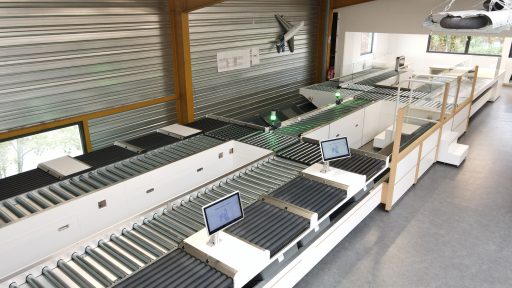Baggage handling: a security and innovation challenge for airports
Reading time: 5 min
To support future years of strong growth in passenger traffic, airports need to modernise their infrastructure and how they process hold and cabin baggage. This is a niche market where innovation is key. We look at the case of TG Concept, a VINCI Energies business unit.

©Hélodée
Four years ago, air travel was pronounced dead, but instead is back stronger than ever. After two disastrous pandemic-hit years, worldwide passenger numbers returned to 2019 levels during 2024, and the International Air Transport Association (IATA) now expects passenger numbers to double by 2043. While these projections serve to remind this sector of its environmental responsibilities in light of its high greenhouse gas emissions, they also pose immediate security challenges for airport infrastructure.
Recently, major works have been undertaken to make hold-baggage handling systems compliant with the Explosive Detection System Standard 3, the latest European framework for mandatory minimum detection rates in airports.
To install this new generation of baggage handling systems (BHS), many European airports have been forced to make major structural changes to their baggage sorting facilities, which required several years of skilled engineering input from companies specialising in the design and installation of baggage solutions.
Growth market
The IATA expects the number of airports worldwide to increase by 3.6% a year over the next two decades, with particularly strong growth in the Asia-Pacific region, especially India and China. “The indicators are clearly promising for international project development,” says Pierre Varnier, CEO of TG Concept, which specialises in the design, integration and commissioning of baggage sorting and screening systems for airports.
“The indicators are clearly promising for international project development.”
This Lyon-based VINCI Energies business unit is a partner to almost 80% of French airports and also has operations in Switzerland (Geneva), Bulgaria (Sofia), Portugal (Lisbon) and Mexico (Monterrey).
“Our collaboration with VINCI Airports on various projects is proving particularly effective,” adds the CEO. “Our current objective is to confirm our leadership, in France of course, but neighbouring countries as well, in the market for baggage handling systems and screening stations.”
Innovation and automation
This is a niche market in which competition plays out primarily through innovation. The automation of conveyor systems is a priority R&D area, for which TG Concept is drawing in 2025 on the potency of Actemium, the VINCI Energies industry brand, to create a proof of concept (POC) based on robots designed to load and unload hold baggage automatically. “In the short term, Actemium should be able to scale up this solution to offer customers in the airport sector a significant innovation,” says Pierre Varnier.
Following two years’ R&D, TG Concept has launched an innovative hold-baggage screening (HBS) concept – the X‑Lane, which offers two key advantages. Line length is reduced to 17 metres, around 10 metres shorter than the lines its competitors currently have to offer. And in addition, X-Lane offers considerable economies of scale by combining two lines into one, allowing airports to reduce both their investment costs and the number of operators required. In other words, it ensures optimised investment (CapEx) and operating (OpEx) costs.
Pierre Varnier adds: “X‑Lane includes interactive information screens aimed at frequent flyers, automatic systems angled at 45 degrees under the preparation tables, and buffer zones to allow operators more time to make decisions.” Developed as a prototype in April 2024, X‑Lane is now in the marketing phase and expected to enter operation in a first European airport during the first quarter of 2025.
Toward a reduced environmental footprint
From an environmental viewpoint, innovation in baggage-handling and screening systems also helps to reduce an airport’s carbon footprint. “TG Concept is naturally aligned with the objectives of the VINCI Group, which is targeting a reduction of over 40% in its Scope 1 and 2 emissions by 2030, compared with 2018, but also going further,” emphasises Pierre Varnier, CEO of TG Concept (VINCI Energies). “We are activating a number of levers in support of this: encouraging short loops in our choice of suppliers; applying life-cycle analysis (LCA) methods; and prioritising sustainable materials, especially aluminium, which has a higher recycling coefficient than steel. And to orchestrate this approach, the business unit has introduced the role of environmental project manager.”
02/14/2025





